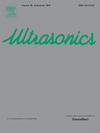使用阿仑膦酸钠增强经颅聚焦超声在成功的脑内消融中的传输
IF 4.1
2区 物理与天体物理
Q1 ACOUSTICS
引用次数: 0
摘要
目的:本研究的目的是评估阿仑膦酸钠治疗对既往经颅磁共振引导聚焦超声(MRgFUS)消融失败患者颅骨骨密度分布及相应超声通透性的改善效果。评估阿仑膦酸钠治疗改变颅骨特征和提高重复MRgFUS手术成功率的能力。方法:5例最初MRgFUS消融失败的患者接受了6-12个月的阿仑膦酸钠治疗以改善骨密度。重复进行MRgFUS检查,并利用CT和MR成像统计评估颅骨密度比(SDR)和峰值焦温的变化。引入并分析了颅骨骨密度直方图作为附加度量。结果:治疗后5例患者中有4例SDR升高(由0.378±0.037增至0.424±0.045,p>0.05)。所有重复操作均成功。超声平均最高病灶温度从53.6±4.0°C上升至55.7±4.1°C (p=0.018),患者最高体温从57.0±2.4°C上升至60.2±1.8°C (p=0.031)。CT直方图显示低密度体素减少,提示骨小梁骨密度增加。三维CT扫描配准显示局部密度改变,缺陷填充,空洞减少。结论:阿仑膦酸钠治疗增强颅骨骨密度分布,从而提高超声通透性,有助于成功重复MRgFUS。通过可视化地分析CT变化,医疗保健专业人员可以更好地告知他们关于重复手术的决策。这一方法扩大了低SDR患者接受MRgFUS治疗的范围,并强调了阿仑膦酸钠在改善治疗结果方面的潜在益处。本文章由计算机程序翻译,如有差异,请以英文原文为准。
The use of alendronate to enhance transcranial transmission of focused ultrasound for successful ablations in brain
Objective:
The aim of this study was to evaluate the efficacy of alendronate therapy in improving bone density distribution in skull bones and corresponding ultrasound permeability in patients who had previously experienced unsuccessful transcranial MR-guided focused ultrasound (MRgFUS) ablation. The ability of alendronate treatment to modify skull bone characteristics and enhance the success rate of repeat MRgFUS procedures was assessed.
Methods:
Five patients with initially unsuccessful MRgFUS ablations underwent a 6–12 month regimen of alendronate to improve bone density. Repeat MRgFUS procedures were performed, and changes in skull density ratio (SDR) and peak focal temperatures were evaluated statistically using CT and MR imaging. Histograms of skull bone density were introduced and analysed as an additional metric.
Results:
After therapy, SDR increased in four out of five patients (from 0.378±0.037 to 0.424±0.045, ). All repeated procedures were successful. The maximum focal temperature, averaged over sonications, increased from 53.6±4.0 °C to 55.7±4.1 °C (p=0.018), while the maximum temperature per patient rose from 57.0±2.4 °C to 60.2±1.8 °C (p=0.031). Histograms of CT scans showed a reduction in low-density voxels, indicating trabecular bone densification. 3D CT scan registration revealed local density changes, defect filling, and void reduction.
Conclusions:
Alendronate therapy enhanced skull bone density distribution and thus ultrasound permeability, which has facilitated successful repeat MRgFUS. By visually analysing CT changes, healthcare professionals can better inform their decision-making regarding repeat surgeries. This method broadens the pool of patients with low SDR eligible for MRgFUS treatment and underscores the potential benefits of alendronate in improving treatment outcomes.
求助全文
通过发布文献求助,成功后即可免费获取论文全文。
去求助
来源期刊

Ultrasonics
医学-核医学
CiteScore
7.60
自引率
19.00%
发文量
186
审稿时长
3.9 months
期刊介绍:
Ultrasonics is the only internationally established journal which covers the entire field of ultrasound research and technology and all its many applications. Ultrasonics contains a variety of sections to keep readers fully informed and up-to-date on the whole spectrum of research and development throughout the world. Ultrasonics publishes papers of exceptional quality and of relevance to both academia and industry. Manuscripts in which ultrasonics is a central issue and not simply an incidental tool or minor issue, are welcomed.
As well as top quality original research papers and review articles by world renowned experts, Ultrasonics also regularly features short communications, a calendar of forthcoming events and special issues dedicated to topical subjects.
 求助内容:
求助内容: 应助结果提醒方式:
应助结果提醒方式:


